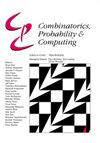Approximate discrete entropy monotonicity for log-concave sums
IF 0.8
4区 数学
Q3 COMPUTER SCIENCE, THEORY & METHODS
引用次数: 0
Abstract
Abstract It is proven that a conjecture of Tao (2010) holds true for log-concave random variables on the integers: For every $n \geq 1$ , if $X_1,\ldots,X_n$ are i.i.d. integer-valued, log-concave random variables, then \begin{equation*} H(X_1+\cdots +X_{n+1}) \geq H(X_1+\cdots +X_{n}) + \frac {1}{2}\log {\Bigl (\frac {n+1}{n}\Bigr )} - o(1) \end{equation*} as $H(X_1) \to \infty$ , where $H(X_1)$ denotes the (discrete) Shannon entropy. The problem is reduced to the continuous setting by showing that if $U_1,\ldots,U_n$ are independent continuous uniforms on $(0,1)$ , then \begin{equation*} h(X_1+\cdots +X_n + U_1+\cdots +U_n) = H(X_1+\cdots +X_n) + o(1), \end{equation*} as $H(X_1) \to \infty$ , where $h$ stands for the differential entropy. Explicit bounds for the $o(1)$ -terms are provided.对数凹和的近似离散熵单调性
摘要证明了Tao(2010)的一个猜想对于整数上的凹对数随机变量成立:对于每一个$n \geq 1$,如果$X_1,\ldots,X_n$是i.i.d个整数值的凹对数随机变量,则\begin{equation*} H(X_1+\cdots +X_{n+1}) \geq H(X_1+\cdots +X_{n}) + \frac {1}{2}\log {\Bigl (\frac {n+1}{n}\Bigr )} - o(1) \end{equation*}为$H(X_1) \to \infty$,其中$H(X_1)$表示(离散的)香农熵。通过表明如果$U_1,\ldots,U_n$是$(0,1)$上的独立连续制服,则\begin{equation*} h(X_1+\cdots +X_n + U_1+\cdots +U_n) = H(X_1+\cdots +X_n) + o(1), \end{equation*}为$H(X_1) \to \infty$,其中$h$代表微分熵,问题被简化为连续设置。提供了$o(1)$ -项的显式边界。
本文章由计算机程序翻译,如有差异,请以英文原文为准。
求助全文
约1分钟内获得全文
求助全文
来源期刊

Combinatorics, Probability & Computing
数学-计算机:理论方法
CiteScore
2.40
自引率
11.10%
发文量
33
审稿时长
6-12 weeks
期刊介绍:
Published bimonthly, Combinatorics, Probability & Computing is devoted to the three areas of combinatorics, probability theory and theoretical computer science. Topics covered include classical and algebraic graph theory, extremal set theory, matroid theory, probabilistic methods and random combinatorial structures; combinatorial probability and limit theorems for random combinatorial structures; the theory of algorithms (including complexity theory), randomised algorithms, probabilistic analysis of algorithms, computational learning theory and optimisation.
 求助内容:
求助内容: 应助结果提醒方式:
应助结果提醒方式:


